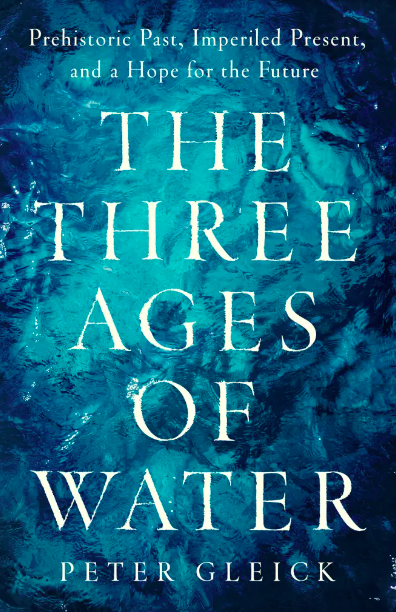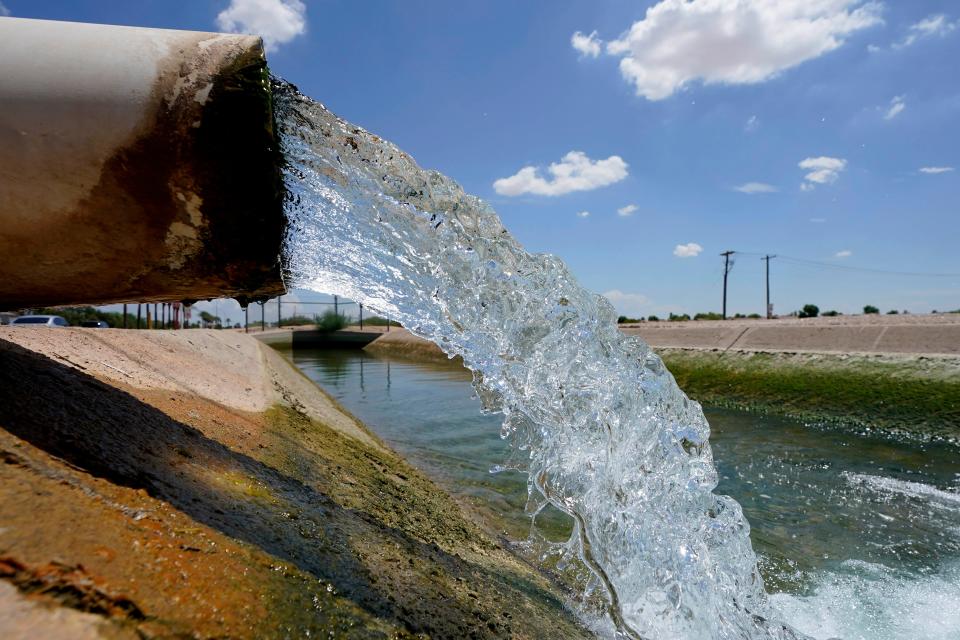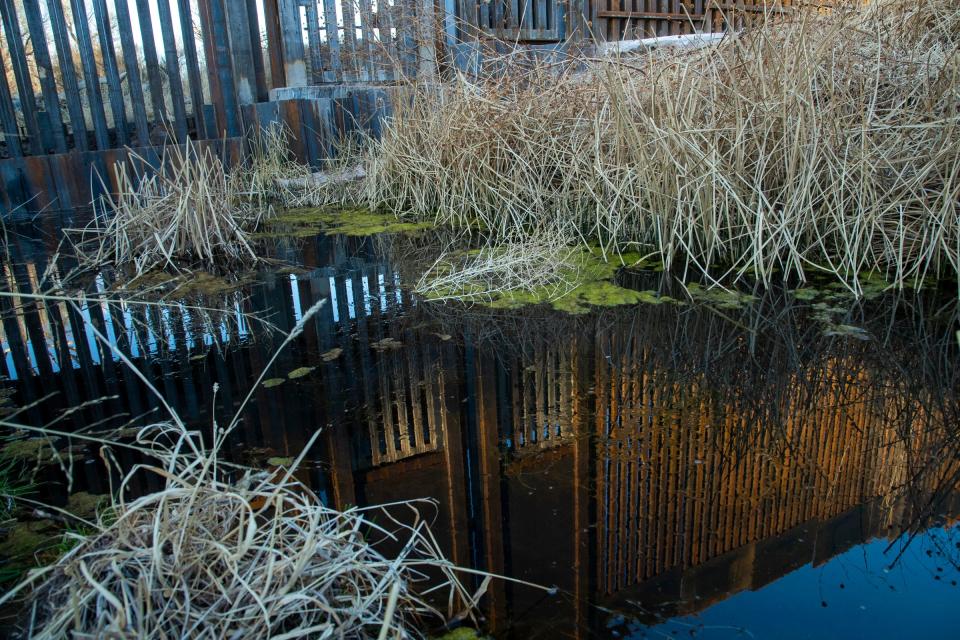New book tells the story of water across three ages, offering a path forward
Water expert Peter Gleick's new book starts with a bang — The Big Bang.
To kick off his comprehensive overview of humanity's relationship with water, he goes back to the very beginning, to the creation of hydrogen and oxygen atoms that later bonded to form water and make life on Earth possible. From there, he works his way up the channel of water history, noting where various tributary events tie in, to explain the origins of and suggest solutions to many of our most pressing modern challenges.
In "The Three Ages of Water: Prehistoric Past, Imperiled Present, and a Hope for the Future," published Tuesday by Public Affairs Books, Gleick outlines how early humans struggled to survive the unpredictable moods of the hydrologic cycle, often by migrating away from catastrophic droughts or floods. Later, he writes, Homo sapiens learned to tame water woes via impressive engineering feats like wells, dams, aqueducts, irrigation canals and purification treatments that enabled our species to expand and thrive.
But now, Gleick argues, our exploitative and wasteful attitudes about water endanger our own survival.

Gleick is a California-based scientist and communicator whose work on global water and environmental issues has been recognized with a MacArthur “genius” grant, the U.S. Water Prize and election to the U.S. National Academy of Sciences. He is a co-founder of the Pacific Institute, a non-governmental organization based in Oakland focused on solving modern water challenges and advancing global sustainability.
"Three Ages" is Gleick's 14th book about water. And across its 300 pages, he leaves no historical stone unturned.
After starting with the birth of the universe, he weaves in lengthy descriptions of excavated aqueducts from ancient civilizations, evidence for Noah's Ark-type flood stories common across many cultures, details on the pathology of various water-borne diseases, farmer testimonials from the 1930s Dust Bowl, the origins of our addiction to bottled water, the drought context of the Syrian civil war and many other H20-related anecdotes sure to fascinate readers who are willing to stick with the book's sometimes meandering course.
To lend some structure to this collection of water facts, Gleick divides the human history of water into three parts: the "First Age of Water," marked by primitive attempts at channeling water for agriculture and flood prevention and early violent conflicts over its control; the "Second Age of Water," when humans gained dominion over water flows to the point where its storage behind huge dams has shifted the balance of Earth's mass as measured from space; and, finally, the future "Third Age of Water," when the global community will face serious decisions about how to protect this resource from overbearing and destructive human mastery.
"If we fail to achieve the positive future for water, it won't be because we can't," Gleick writes in his final chapter. "It will be because we didn't."

First Age: Water rules the lives of early humans
If you've ever wondered about the prevalence of water in our solar system and its discovery in different forms on other planets, Gleick's first chapter is a good place to start. After touching on now-debunked theories about the presence of artificial water canals on Mars that date back to the 1870s, he describes the two outermost planets, Uranus and Neptune, as "ice giants containing vast amounts of frozen water in their mantles, rings, and moons."
This discussion leads into one about the fragility of the existence of water on Earth — held in and kept at a usable temperature by our delicate atmosphere. The simultaneous presence of water as a vapor, as ice and as a flowing, drinkable liquid has made the evolution of lifeforms on this planet possible.
Since its formation on Earth 4.4 billion years ago, liquid water has supported the rise of atmospheric oxygen, cells with nuclei and then dinosaurs. The arrival of humans about 200,000 years ago marked the beginning of the age of its attempted control.
More book reviews: Arizona author charts a course through 1930s science and sexism on the Colorado River
For a long time, these efforts were largely unsuccessful and early humans were ruled by the vagaries of water. Gleick recounts similar stories about a massive, Earth-cleansing flood originating from past cultures in different parts of the world, from "The Epic of Gilgamesh" translated from stone tablets dating back to ancient Mesopotamia to flood stories in Greek and Latin involving Zeus and other gods to Hindu versions with a hero named Manu to the Jewish and Christian accounts of Noah.
These stories predated the explosion of efforts to control water flows using small dams, aqueducts and irrigation canals. An ancient Chinese legend tells of a king 4,000 years ago who became known as the "Great Yu Who Controlled the Waters" for the flood control relief he brought to his people. Around the same time, thousands of underground channels were dug in modern-day Iran and the Arabian peninsula to deliver groundwater to parched cities wanting to grow. Early Rome, Gleick writes, supported up to a million people with an aqueduct system that brought fresh water from more than 50 miles away.
These efforts to manipulate the flow of water away from one region to another quickly became sources of conflict between neighboring civilizations. The world's first-known water war took place nearly 4,500 years ago in what is now Iraq. In some places of the world, Gleick says these conflicts have never stopped, and many have worsened with the advanced engineering made possible in the Second Age of water.
Second Age: Humans learn to harness the forces of water
Gleick's modern "Second Age" of water, which he describes as "the flowering of science, art, technology, and knowledge," makes up the bulk of his book with a lot of historical ground to cover.
Starting once again with the existence of atoms, he begins this section by asking "What is water?" and launches into a retelling of related philosophical debates and the 18th-century experiments that led to the invention of the steam engine and the water pump. These tools enabled the supply of fresh water to growing but inopportunely located cities like New York.
But the population growth this technology made possible outpaced understanding of sanitation and how diseases spread. Despite many improvements since, the World Health Organization estimated that 820,000 people died worldwide in 2017 of diarrheal diseases resulting from inadequate access to safe water and sanitation, Gleick writes.
In developed nations, the expansion of water infrastructure and wastewater treatment to most (but not all — 10,000 homes on the Navajo Nation are still without running water or an indoor bathroom) residents solved many problems but created others.
"In 2018 the US Environmental Protection Agency estimated that more than $470 billion will be needed to replace and update existing pipelines, build and expand water-treatment systems, and provide water storage and supply for the nation's drinking-water infrastructure over the next twenty years, an amount far in excess of what is currently being invested," Gleick writes.
Moral water questions on Navajo Nation: As the Supreme Court debates a Navajo water rights case, climate change adds new questions
Failures of water treatment and transport systems, like the one that exposed residents of Flint, Michigan, to dangerous levels of lead in 2014, have created mistrust of tap water that has given rise to the harmful popularity of bottled water. This industry now generates massive quantities of plastic waste and emission of greenhouse gases into the atmosphere each year, worsening climate change and related flood and drought cycles.
The environmental damage of our water control issues percolates further. Modern agriculture is responsible for deeply unsustainable withdrawals from underground aquifers and surface water sources, Gleick writes. And limited regulation of pollutants from agriculture and industry degrade the quality of our remaining natural waterways, exacerbating a modern biodiversity crisis.
Global wetland area has dropped by half since 1970, Gleick notes, with an associated 83% decline in thousands of species of birds, fish, amphibians, mammals and reptiles. Perhaps printed just a few weeks too soon, his book makes no mention of a decision last month by the U.S. Supreme Court that limits protections for wetlands under the Clean Water Act, further worrying many scientists and environmental advocates.
"Many regions of the world now appear to be reaching or even passing the point of peak ecological water," Gleick writes at the end of his section on the Second Age, describing a point at which the ecological cost of removing water from nature exceeds the economic benefit.

Third Age: Going forward, a course change is needed
In the final section of his book, Gleick guides readers to a fork in the river of our future and explains what we will need to do to steer ourselves into the more sustainable, equitable channel.
"We have a clear choice," he writes. "Society can continue to push along the Second Age of Water's "hard path" ... or it can shift to what I have called the "soft path for water.""
The "hard path" relied on physical infrastructure to produce important services and advances, he explains. But it failed to provide those benefits to everyone or to consider the broader environmental consequences. Now, instead, he says we must protect the health of critical ecosystems, assert the human right to water and work together to maximize public goods.
The preferred "soft path" for water has five key characteristics, he writes:
We must recognize the human right to water and focus on meeting water-related needs.
We must recognize the true value of water as more than just the economics of the goods it can produce.
We must protect the health of ecosystems by guaranteeing the water needed to support them.
We must shift to providing the health, food, goods and services people want in the most efficient way possible.
We must put treated wastewater, gray water and storm water to use to increase water availability without taking more from nature.
Read the climate series: The latest from Joan Meiners at azcentral, a column on climate change that publishes weekly
Surveys have shown that Americans are willing to pay $40 to $50 billion per year to improve water quality to swimmable, fishable and boatable standards. And wastewater treatment has advanced to a point where it is possible to covert flushed liquids to a higher quality than most current drinking water. (This is, after all, what they do with impressive efficiency on the International Space Station, Gleick points out.) The WHO estimates that every $1 invested in water and sanitation returns more than $4 in benefits.
Yet, these are not options we are currently taking. A large navigational shift is needed.
Gleick concludes his book with a quote from the late biologist E.O. Wilson:
"The real problem of humanity is the following: we have Paleolithic emotions, medieval institutions, and godlike technology."
Gleick views these as solvable problems. He posits that a basic emotional attachment to water may ultimately help people do what is necessary to protect it. Institutions can be modernized, if popular vote demands it. And, if corporations and governments can be moved toward social responsibility and environmental stewardship, modern technology can be harnessed for water preservation rather than continuing on the damaging path of water exploitation.
More specific direction, along with innumerable fascinating water anecdotes, can be found in the pages of "The Three Ages of Water."
Joan Meiners is the climate news and storytelling reporter at The Arizona Republic and azcentral.com. Before becoming a journalist, she completed a doctorate in ecology. Follow Joan on Twitter at @beecycles or email her at joan.meiners@arizonarepublic.com. Read more of her coverage at environment.azcentral.com.
Support climate coverage and local journalism by subscribing to azcentral.com at this link.
This article originally appeared on Arizona Republic: Peter Gleick tells the story of water and its power over people

